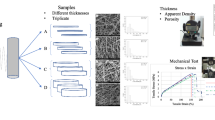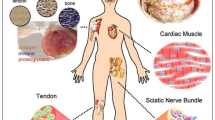Abstract
Increasing bioactivity and mechanical properties of polymers to produce more suitable scaffold for tissue engineering is a recurrent goal in the development of new biomedical materials. In this study, collagen-functionalized poly (lactic acid), PLA, was obtained by means of a simple grafting route, and electrospun scaffolds were produced to grow cells in vitro; their bioactivity was compared with scaffolds made of physical blends of PLA and collagen. Grafting was verified via nuclear magnetic resonance, attenuated total reflection-Fourier transform infrared and X-ray photoelectron spectroscopy. The cell adhesion performance of the scaffolds was studied using macrophages. Elastic modulus (74.7 megapascals) and tensile strength (3.0 megapascals) of the scaffold made from PLA grafted with collagen were substantially higher than the scaffolds made from physical blends of collagen and PLA: 32 and 2.16 megapascals, respectively, implying a more resistant material because of the chemical bond of the polypeptide to PLA. Besides, the fibers had more uniform diameter without defects. Scaffolds made from PLA grafted with collagen presented four-fold increase in cell adhesion than those of PLA blended with collagen. Furthermore, cell spreading within the scaffolds occurred only when collagen-functionalized poly (lactic acid) was used. These results open a new option for the easy tailoring of nanofiber-based scaffolds in three dimensions for tissue engineering.
Similar content being viewed by others
References
Laurie GW, Horikoshi S, Killen PD, Segui-Real B, Yamada Y. In situ hybridization reveals temporal and spatial changes in cellular expression of mRNA for a laminin receptor, laminin, and basement membrane (type IV) collagen in the developing kidney. J Cell Biol 1989;109:1351–1362.
Sanes JR, Engvall E, Butkowski R, Hunter DD. Molecular heterogeneity of basal laminae: isoforms of laminin and collagen IVat the neuromuscular junction and elsewhere. J Cell Biol 1990;111:1685–1699.
Werb Z, Chin JR. Extracellular matrix remodeling during morphogenesis. Ann N YAcad Sci 1998;857:110–118.
Boudreau N, Myers C, Bissell MJ. From laminin to lamin: regulation of tissue-specific gene expression by the ECM. Trends Cell Biol 1995;5:1–4.
Ingber D. Extracellular matrix and cell shape: potential control points for inhibition of angiogenesis. J Cell Biochem 1991;47:236–241.
Lannutti J, Reneker D, Ma T, Tomasko D, Farson D. Electrospinning for tissue engineering scaffolds. Mat Sci Eng C 2007;27:504–509.
Agarwal S, Greiner A, Wendorff JH. Electrospinning of manmade and biopolymer nanofibers-progress in techniques, materials, and applications. Adv Funct Mater 2009;19:2863–2879.
Agarwal S, Wendorff JH, Greiner A. Use of electrospinning technique for biomedical applications. Polymer 2008;49:5603–5621.
Baker SC, Atkin N, Gunning PA, Granville N, Wilson K, Wilson D, et al. Characterisation of electrospun polystyrene scaffolds for three-dimensional in vitro biological studies. Biomaterials 2006;27:3136–3146.
Yang F, Murugan R, Ramakrishna S, Wang X, Ma YX, Wang S. Fabrication of nano-structured porous PLLA scaffold intended for nerve tissue engineering. Biomaterials 2004;25:1891–1900.
Hench LL, Jones JR. Biomaterials, artificial organs and tissue engineering. Cambridge: Woodhead Publishing Ltd.; 2005.
Zhang Y, Lim CT, Ramakrishna S, Huang ZM. Recent development of polymer nanofibers for biomedical and biotechnological applications. J Mater Sci Mater Med 2005;16:933–946.
Vasita R, Katti DS. Nanofibers and their applications in tissue engineering. Int J Nanomed 2006;1:15–30.
Huang ZM, Zhang YZ, Kotakic M, Ramakrishna S. A review on polymer nanofibers by electrospinning and their applications in nanocomposites. Compos Sci Technol 2003;63:2223–2253.
Smith R. Biodegradable polymers for industrial applications. Cambridge: Woodhead Publishing Ltd.; 2005.
Lee J, Tae G, Kim YH, Park IS, Kim SH, Kim SH. The effect of gelatin incorporation into electrospun poly(L-lactide-co-epsilon-caprolactone) fibers on mechanical properties and cytocompatibility. Biomaterials 2008;29:1872–1879.
Charulatha V, Rajaram A. Influence of different crosslinking treatments on the physical properties of collagen membranes. Biomaterials 2003;24:759–767.
Friess W. Collagen—biomaterial for drug delivery. Eur J Pharm Biopharm 1998;45:113–136.
Ma PX. Biomimetic materials for tissue engineering. Adv Drug Deliv Rev 2008;60:184–198.
Shin H, Jo S, Mikos AG. Biomimetic materials for tissue engineering. Biomaterials 2003;24:4353–4364.
Gunn J, Zhang M. Polyblend nanofibers for biomedical applications: perspectives and challenges. Trends Biotechnol 2010;28:189–197.
Nyanhongo GS,Diaz Rodriguez R, Nugroho Prasetyo E, Cristina C, Ribeiro C, Sencadas V, et al. Bioactive albumin functionalized polylactic acid membranes for improved biocompatibilty. React Funct Polym 2013;73:1399–1404.
Yang X, Yuan M, Li W, Zhang G. Synthesis and properties of collagen/polylactic acid blends. Appl Polym 2004;94:1670–1675.
Yang Y, Porte MC, Marmey P, El Haj AJ, Amédée J, Baquey C. Covalent bonding of collagen on poly(L-lactic acid) by gamma irradiation. Nucl Instrum Methods Phys Res Sect B 2003;207:165–174.
Rasal RM, Janorkar AV, Hirt DE. Poly(lactic acid) modifications. Prog Polym Sci 2010;35:338–356.
Cui YL, Qi AD, Liu WG, Wang XH, Wang H, Ma DM, et al. Biomimetic surface modification of poly(L-lactic acid) with chitosan and its effects on articular chondrocytes in vitro. Biomaterials 2003;24:3859–3868.
Croll TI, O’Connor AJ, Stevens GW, Cooper-White JJ. Controllable surface modification of poly(lactic-co-glycolic acid) (PLGA) by hydrolysis or aminolysis I: physical, chemical, and theoretical aspects. Biomacromolecules 2004;5:463–473.
Goddard JM, Hotchkiss JH. Polymer surface modification for the attachment of bioactive compounds. Prog Polym Sci 2007;32:698–725.
Cui M, Liu L, Guo N, Su R, Ma F. Preparation, cell compatibility and degradability of collagen-modified poly(lactic acid). Molecules 2015;20:595–607.
Luo YF, Wang YL, Niu XF, Pan J, Shi LP. Synthesis and characterization of a novel biomaterial: maleic anhydride-modified poly(dl-lactic acid). Chin Chem Lett 2014;15:521–524.
Pan J, Wang Y, Qin S, Zhang B, Luo Y. Grafting reaction of poly(D,L)lactic acid with maleic anhydride and hexanediamine to introduce more reactive groups in its bulk. J Biomed Mater Res B Appl Biomater 2005;74:476–480.
Niu X, Wang Y, Luo Y, Pan J, Shang J. Synthesis of the biomimetic polymer: aliphatic diamine and RGDS modified poly(D, L-lactic acid). Chin Chem Lett 2005;16:1035–1038.
Vera-Grazianoa R, AMaciel-Cerda A, Moreno-Rondon EV, Ospina A, Gomez-Pachon EY. Modified Polylactide Microfiber Scaffolds for Tissue Engineering. In: Rodil S, Almaguer A, Anselme K, editors. MRS Proceedings. Vol. 1376. Warrendale, PA: Materials Research Society; 2012.
Plackett D. Maleated polylactide as an interfacial compatibilizer in biocomposites. J Polym Environ 2004;12:131–138.
Kang IK, Kwon BK, Lee JH, Lee HB. Immobilization of proteins on poly(methyl methacrylate) films. Biomaterials 1993;14:787–792.
Gómez-Pachón E, Sânchez-Arévalo FM, Sabina FJ, Maciel-Cerda A, Campos MR, Batina N, et al. Characterisation and modelling of the elastic properties of poly(lactic acid) nanofibre scaffolds. J Materials Sci 2013;48:8308–8319.
Su R, Liu L, Li X, Cui M, Ma F. Study on synthesis and application of collagen modified polylactic acid. Polym Compos 2015;36:88–93.
ASTM D1708-96. Standard test method for tensile properties of plastics by use of microtensile specimens. West Conshohocken, PA: ASTM International; 2002. DOI: 10.1520/D1708-96.
Fowlks AC. Development of polylactic acid-based materials through reactive modification. Ann Arbor: Michigan State University; 2010.
Muenprasat D, Suttireungwong S, Tongpin C. Functionalization of poly (lactic acid) with maleic anhydride for biomedical application. J Met Mater Min 2010;20:189–192.
Li X, Liu LL, Yang PF, Li P, Xin JJ, Su RX. Synthesis of collagen-modified polylactide and its application in drug delivery. J Appl Polym Sci 2013;129:3290–3296.
Meng ZX, Wang YS, Ma C, Zheng W, Li L, Zheng YF. Electrospinning of PLGA/gelatin randomly-oriented and aligned nanofibers as potential scaffold in tissue engineering. Mater Sci Eng C 2010;30:1204–1210.
Hwang SW, Lee SB, Lee CK, Lee JY, Shim JK, Susan EM, et al. Grafting of maleic anhydride on poly(L-lactic acid). Effects of physical and mechanical properties. Polym Test 2012;31:333–344.
Anderson JM, Rodriguez A, Chang DT. Foreign body reaction to biomaterials. Semin Immunol 2008;20:86–100.
Brown BN, Ratner BD, Goodman SB, Amar S, Badylak SF. Macrophage polarization: an opportunity for improved outcomes in biomaterials and regenerative medicine. Biomaterials 2012;33:3792–3802.
Almeida CR, Serra T, Oliveira MI, Planell JA, Barbosa MA, Navarro M. Impact of 3-D printed PLA- and chitosan-based scaffolds on human monocyte/macrophage responses: unraveling the effect of 3-D structures on inflammation. Acta Biomater 2014;10:613–622.
Pouchert CJ. Aldrich Library of NMR Spectra. 2nd ed. Milwaukee, WI: Aldrich Chemical Co.; 1983. p. 1–603.
Pretsch E, Bühlmann P, Badertscher M. Structure determination of organic compounds. 4th ed. Berlin Heidelberg: Springer-Verlag; 2009. p. 224.
Cui W, Li X, Xie C, Zhuang H, Zhou S, Weng J. Hydroxyapatite nucleation and growth mechanism on electrospun fibers functionalized with different chemical groups and their combinations. Biomaterials 2010;31:4620–4629.
Cao C, Zhu F, Yu X, Wang Q, Wang C, Li B, et al. Two-step modification of poly(D, L-lactic acid) by ethylenediamine-maleic anhydride. Biomed Mater 2008;3:015002.
Wen F, Chang S, Teoh SH, Yu H. Preparation of biocompatible poly(lactic-coglycolic acid) fiber scaffolds for rat liver cells cultivation. Mater Sci Eng C 2007;27:285–292.
Kwon IK, Matsuda T. Co-electrospun nanofiber fabrics of poly(l-lactide-co-ε-caprolactone) with type I collagen or heparin. Biomacromolecules 2005;6:2096–2105.
Gonçalves F, Bentini R, Burrows MC, Carreira ACO, Kossugue PM, Sogayar MC, et al. Hybrid membranes of PLLA/collagen for bone tissue engineering: a comparative study of scaffold production techniques for optimal mechanical properties and osteoinduction ability. Materials 2015;8:408–423.
Author information
Authors and Affiliations
Corresponding author
Rights and permissions
About this article
Cite this article
Ospina-Orejarena, A., Vera-Graziano, R., Castillo-Ortega, M.M. et al. Grafting collagen on poly (lactic acid) by a simple route to produce electrospun scaffolds, and their cell adhesion evaluation. Tissue Eng Regen Med 13, 375–387 (2016). https://doi.org/10.1007/s13770-016-9097-y
Received:
Revised:
Accepted:
Published:
Issue Date:
DOI: https://doi.org/10.1007/s13770-016-9097-y




